



BIOLUMINESCENCE IN WATASENIA SCINTILLANS (FIREFLY SQUID) Presented by: Timothy Goh Biol 428 Winter 2015 “ Some things which are not fire nor forms of fire seem to produce light by nature ” – Aristotle (~2,500 years ago)
OUTLINE 1. Introduction 2. Light generating mechanism 3. Adaptation 4. The origin of bioluminescence 5. Conclusion and future of bioluminescence
INTRODUCTION • Commonly known as “hotaru-ika” or the firefly squid • Found only in Japan – Toyoma Bay • 1-year life cycle • Large array of photophores throughout the body • Emits blue light
CHALLENGES • They cannot be kept alive for more than 3-5 days in captivity • The animal dies in about 10-20 min when taken out of water causing irreversible damage to the photophores • The luminescence system is highly unstable even when the photophores are kept in an ice bath
1. LIGHT GENERATING MECHANISM • 2 ways to generate light: (a) internal biochemical reaction à my species! (b) symbiotic luminous bacteria • Luciferin-luciferase reaction: Light generating mechanism à adaptation à origin of bioluminescence à conclusion and future
ü ATP ü Oxygen ü pH 8.8 CONCLUSION: ATP or Oxygen alone is not sufficient. Both are necessary. (Tsuji, 2002) Light generating mechanism à adaptation à origin of bioluminescence à conclusion and future
2. ADAPTATION • Most cephalopods are color blind because they only have one visual pigment in their retina (Brown & Brown, 1958) • Instead of perceiving color, most cephalopods are found to utilize contrast • Cephalopods contrast difference à 15% • Humans contrast difference à 2% WHY BOTHER BIOLUMINESCENCE WHEN THEY CANNOT EVEN SEE COLOR ???!! Light generating mechanism à adaptation à origin of bioluminescence à conclusion and future
WATASENIA IS AN EXCEPTION • They have 3 visual pigments in their retina (Michinomae et al., 1994) • 2 of the photopigments (470nm & 500 nm) are present in the proximal part of the retina • The other photopigment (484nm) is present in the both distal and proximal part of the retina . HERE COMES ANOTHER PROBLEM! Chromatic defocus à different wavelength of light focusing on different parts of the retina creating a blurry image Light generating mechanism à adaptation à origin of bioluminescence à conclusion and future
Problem solved: A bank of photoreceptors • sensitive to short and long wavelength. (Kröger & Gislén, 2004) This allows visualization of well focused images A: Chromatic defocus B: Chromatic defocus solved Bank of photoreceptors + layered organization à maximizes sensitivity and sharpness Light generating mechanism à adaptation à origin of bioluminescence à conclusion and future
3. ORIGIN OF BIOLUMINESCENCE • Complex diversity of mechanism use to generate light suggests that perhaps multiple independent origins of bioluminescence arose over the course of evolution. (Buck, 1978) • Current hypothesis: (a) luciferin à shape the evolution of bioluminescence (b) luciferase à serves to express the chemiluminescent properties of luciferin Light generating mechanism à adaptation à origin of bioluminescence à conclusion and future
• Research has shown that photogenic substrate (luciferin) has a strong antioxidative property à highly reactive with ROS (Suzuki, 1993) • Proposed that luciferin (Rees et al., 1998) : Original function à detoxify the deleterious effect of ROS Animals started colonizing deeper layers of the ocean 1) Low penetration by sunlight. lower ROS 2) Decrease in metabolic activity, decrease ROS Evolved function: functional shift from detoxification to light-emitting Light generating mechanism à adaptation à origin of bioluminescence à conclusion and future
4. FUTURE Agriculture Medicine Light generating mechanism à adaptation à origin of bioluminescence à conclusion and future
SUMMARY 1. Light is generated via the luciferin-luciferase complex for Watasenia scintillans. 2. BOTH oxygen and ATP are necessary for the generation of light in Watasenia scintillans . 3. Most cephalopods are color blind BUT Watasenia scintillans evolve retina that contains 3 types of photopigments. 4. Bank of photoreceptors + layered organization à maximizes sensitivity and sharpness 5. It is suggested that bioluminescence might have arose multiple times independently across various phyla 6. Photogenic substrate (luciferin) might have undergone a functional shift from detoxification of ROS to the production of light. Light generating mechanism à adaptation à origin of bioluminescence à conclusion and future
Bibliography Brown, P. K, and P. S Brown. "Visual Pigments of the Octopus and Cuttlefish." Nature 182 (1958): 1288–1290. Buck, J. B. "Functions and Evolution of Bioluminescence. In Bioluminescence in Action (ed. P. J. H. Herring)." London: Academic Press (1978): 419-60. Kröger, Ronald H.H., and Anna Gislén. "Compensation for Longitudinal Chromatic Aberration in the Eye of the Firefly Squid, Watasenia Scintillans." Vision Research 44 (2004): 2129–2134. Michinomae, M., H. Masuda, M. Seidou, and Y. Kito. "Structural Basis for Wavelength Discrimination in the Banked Retina of the Firefly Squid Watasenia Scintillans." Journal of Experimental Biology 193 (1994): 1-12. Rees, Jean-François, Bertrand De Wergifosse, Olivier Noiset, Marlene Dubuisson, Bernadette Janssens, and Eric M. Thompson. "The Origins of Marine Bioluminescence: Turning Oxygen Defence Mechanisms into Deep-sea Communication Tools." The Journal of Experimental Biology 201 (1998): 1211–1221. Suzuki, N. "Antioxidative Activity of Some Biologically Active Compounds with Active Oxygen Species." Spectrum 6 (1993): 21-26. Tsuji, Frederick. "Bioluminescence Reaction Catalyzed by Membrane-bound Luciferase in the ‘‘firefly Squid,’’ Watasenia Scintillans." Biochimica Et Biophysica Acta 1564 : 189– 197.
Recommend
More recommend